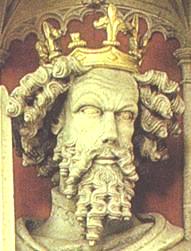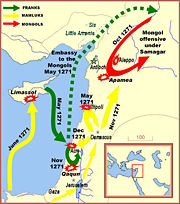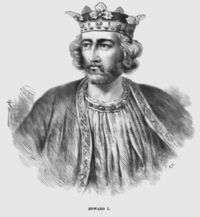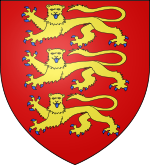Plantagenet
Pedigree
By the Grace of God, King of England, Lord of Ireland, and Duke
of Aquitaine

Statue of Edward I from York MinsterTitles and styles
The King
The Earl of Chester
Edward Plantagenet
|
16 November 1272 – 7 July 1307
Coronation 19 August 1274
Predecessor: Henry III
Successor: Edward II
Consort:
Eleanor of Castile
(1290)
Marguerite of France (1299–)
among others
Issue:
Eleanor, Countess of Bar
Joan, Countess of Hertford and Gloucester
Alphonso, Earl of Chester
Margaret, Duchess of Brabant
Mary Plantagenet
Elizabeth, Countess of Hereford
Edward II
Thomas, 1st Earl of Norfolk
Edmund, 1st Earl of Kent |
| Royal
house |
House
of Plantagenet |
| Father |
Henry
III |
| Mother |
Eleanor
of Provence |
| Born |
17 June1239(1239-06-17)
Palace
of Westminster, London |
| Died |
7 July1307
(aged 68)
Burgh
by Sands, Cumberland |
| Burial |
Westminster
Abbey, London |
Edward I (17
June 1239
– 7 July1307),
popularly known as Longshanks[1],
also as "Edward the Lawgiver" or "the English Justinian" because of his
legal reforms, and as "Hammer of the Scots",[2]
achieved fame as the monarch who conquered Wales
and tried (but failed) to do the same to Scotland.
He reigned from 1272
to 1307, ascending
the throne of England
on 20
November 1272
after the death of his father, King Henry
III. His mother was queen
consort Eleanor
of Provence.
Edward's royal motto was pactum serva, 'Keep troth'. He was voted
the 92nd greatest Briton in the 2002 poll of 100
Greatest Britons.
|
Contents
-
1 Childhood
and marriage to Eleanor
-
2 Early
ambitions
-
3 Military
campaigns
-
3.1 Crusades
-
3.2 Relations
with the Mongols
-
3.3 Accession
-
3.4 Welsh
Wars
-
3.5 Scottish
Wars
-
4 Later
career and death
-
5 Government
and law under Edward I
-
6 Persecution
of the Jews
-
7 Later
contacts with the Mongols
-
8 Ancestry
-
9 Issue
-
10 Portrayal
in fiction
-
11 Notes
-
12 References
-
13 External
Links
|
Childhood and marriage to Eleanor
Edward was born at the
Palace
of Westminster on the evening of
17
June 1239.
[3]
He was an older brother of
Beatrice
of England, Margaret of England and
Edmund
Crouchback, 1st Earl of Lancaster. He was named after
Edward
the Confessor.
[4]
From
1239
to
1246 Edward
was in the care of Hugh Giffard (the son of
Godfrey
Giffard) and his wife, Sybil, who had been one of the
midwives
at Edward's birth. On Giffard's death in
1246,
Bartholomew Pecche took over. Early grants of land to Edward included
Gascony,
but
Simon
de Montfort, 6th Earl of Leicester had been appointed by Henry to seven
years as royal lieutenant in Gascony in
1248,
a year before the grant to Edward, so in practice Edward derived neither
authority nor revenue from the province.
Edward's first marriage (age 15) was arranged in 1254
by his father and Alfonso
X of Castile. Alfonso had insisted that Edward receive grants of land
worth 15,000 marks
a year and also asked to knight him; Henry had already planned a knighthood
ceremony for Edward but conceded. Edward crossed the Channel
in June, and was knighted by Alfonso and married to Eleanor
of Castile (age 13) on 1
November 1254
in the monastery of Las
Huelgas.
Eleanor and Edward would go on to have sixteen children, and her death
in 1290 affected
Edward deeply. He displayed his grief by erecting the Eleanor
crosses, one at each place where her funeral cortège stopped for the
night. His second marriage, (age 60) at Canterbury
on September 10 1299,
to Marguerite
of France, (age 17) (known as the "Pearl of France" by her English
subjects), the daughter of King Philip
III of France (Phillip the Bold) and Maria
of Brabant, produced three children.
Early ambitions
In
1255, Edward
and Eleanor both returned to England. The chronicler
Matthew
Paris tells of a row between Edward and his father over Gascon affairs;
Edward and Henry's policies continued to diverge, and on
9
September 1256,
without his father's knowledge, Edward signed a treaty with
Gaillard
de Soler, the ruler of one of the
Bordeaux
factions. Edward's freedom to manoeuver was limited, however, since the
seneschal
of Gascony,
Stephen
Longespée, held Henry's authority in Gascony. Edward had been granted
much other land, including
Wales
and
Ireland,
but for various reasons had less involvement in their administration.
In 1258,
Henry was forced by his barons to accede to the Provisions
of Oxford. This, in turn, led to Edward becoming more aligned with
the barons and their promised reforms, and on 15
October 1259
he announced that he supported the barons' goals. Shortly afterwards Henry
crossed to France for peace negotiations, and Edward took the opportunity
to make appointments favouring his allies. An account in Thomas
Wykes's chronicle claims Henry learned that Edward was plotting against
the throne; Henry, returning to London in the spring of 1260,
was eventually reconciled with Edward by Richard
of Cornwall's efforts. Henry then forced Edward's allies to give up
the castles they had received and Edward's independence was sharply curtailed.
Edward's character greatly contrasted with that of his father, who reigned
over England throughout Edward's childhood and consistently tended to favour
compromise
with his opponents. Edward had already shown himself as an ambitious and
impatient man, displaying considerable military prowess in defeating Simon
de Montfort at the Battle
of Evesham in 1265,
having previously been imprisoned by de Montfort at Wallingford
Castle and Kenilworth
Castle. He gained a reputation for treating rebels
and other foes with great savagery. He relentlessly pursued the surviving
members of the de Montfort family, his cousins.
Military campaigns
Crusades
In
1269,
Cardinal
Ottobono, the
Papal
Legate, arrived in England and appealed to Prince Edward and his brother
Edmund to participate in the
Eighth
Crusade alongside
Louis
IX of France. In order to fund the crusade, Edward had to borrow heavily
from Louis IX and the French. It is estimated by scholars such as P.R.
Coss that Edward raised and spent close to half a million
livres.
The number of knights and retainers that accompanied Edward on the crusade
was quite small, possibly around 230 knights, other sources stating 1,000.[5]
Many of the members of Edward's expedition were close friends and family
including his wife Eleanor
of Castile, his brother Edmund, and his first cousin Henry
of Almain.
The original goal of the crusade was to relieve the beleaguered Christian
stronghold of Acre,
but Louis had been diverted to Tunis.
By the time Edward arrived at Tunis, Louis had died of disease. The majority
of the French forces at Tunis thus returned home, but a small number joined
Edward who continued to Acre to participate in the Ninth
Crusade. After a short stop in Cyprus,
Edward arrived in Acre with thirteen ships. Then, in 1271,
Hugh
III of Cyprus arrived with a contingent of knights.
Relations with the Mongols
-
See also: Franco-Mongol
alliance

Operations during the Crusade of Edward I.
As soon as Edward arrived in Acre, he sent an embassy to the
Mongol
ruler of
PersiaAbagha,
an enemy of the Muslims. The embassy was led by Reginald Rossel, Godefroi
of Waus and John of Parker, and its mission was to obtain military support
from the Mongols.
[6]
In an answer dated September 4, 1271, Abagha agreed for cooperation and
asked at what date the concerted attack on the Mamluks should take place.
The arrival of the additional forces of Hugh III of Cyprus further emboldened
Edward, who engaged in a raid on the town of Qaqun.
At the end of October 1271, the Mongol troops requested by Edward arrived
in Syria and ravaged the land from Aleppo
southward. Abagha, occupied by other conflicts in Turkestan
could only send 10,000 Mongol horsemen under general Samagar
from the occupation army in SeljukAnatolia,
plus auxiliary Seljukid troops, but they triggered an exodus of Muslim
populations (who remembered the previous campaigns of Kithuqa)
as far south as Cairo.[7]
When Baibars mounted a counter-offensive from Egypt on November 12th,
the Mongols had already retreated beyond the Euphrates,
but these unsettling events allowed Edward to negotiate a ten year peace
treaty with the Mamluks.
At this point Edward was forced to return to England, having heard of
his father's death. He remained in communication with the Mongols, and
when a delegation was sent by Abagha
to the Second
Council of Lyons in 1274, the Mongol embassy visited Edward after the
Council on January 28, 1275. A letter from Edward is known, in which he
acknowledges Abagha's promise to fight together with the Crusaders.[8]
Overall, Edward's crusade was rather insignificant and only gave the
city of Acre a reprieve of ten years. However, Edward's reputation was
greatly enhanced by his participation in the crusade and was hailed by
some contemporary commentators as a new Richard
the Lionheart. Furthermore, some historians believe Edward was inspired
by the design of the castles he saw while on crusade, such as Krak
des Chevaliers, and incorporated similar features into the castles
he built to secure portions of Wales, such as Caernarfon
Castle.
He was also largely responsible for the Tower
of London in the form we see today, including notably the concentric
defences, elaborate entranceways, and the Traitor's
Gate.
Accession
At the time of the death of Henry III, Edward was on the
Crusades.
Upon hearing of the death of Henry III, Edward left the Holy Land and returned
to England. He was crowned after his return, on
19
August 1274.
He initially intended to call himself Edward IV, recognising the three
Saxon kings of England of that name. However, for unknown reasons, this
designation does not appear to have been formally used, the King instead
being known as 'King Edward' not only by custom (for a King would generally
not be known by his regal designation in ordinary conversation), but in
all known formal documentation. Upon the accession of his son, also named
Edward, the custom of the old reign was taken as rule — the new King
was named Edward II, and the old Edward I. Technically, then, this established
the custom of numbering English monarchs only from the Norman Conquest
(although Edward is the only name that has been shared by pre- and
post-Conquest monarchs).
Welsh Wars

Edward I depicted in
Cassell's History of England
(
1902)
One of King Edward's early moves was the conquest of Edward presided over a feudal court held at the castle of Berwick-upon-Tweed
in November 1292, where judgment was given in favour of John
Balliol over other
candidates. Balliol was chosen as the candidate with the strongest
claim in feudal law, but Edward subsequently used the concessions he had
gained to undermine the authority of the new king even summoning Balliol
to do homage
to him in Westminster
in 1293. Edward
also made it clear he expected John's military and financial support against
France. This was too much for Balliol, who concluded a pact with France
and prepared an army to invade England.
Edward's plan to conquer Scotland never came to fruition during his
lifetime, however, as he died in 1307 at Burgh-by-Sands,
Cumberland
on the Scottish border, while on his way to wage another campaign against
the Scots under the leadership of Robert
the Bruce. According to chroniclers, Edward desired to have his bones
carried on Scottish military campaigns, and that his heart be taken to
the Holy Land. Against his wishes, Edward was buried in Westminster
Abbey in a plain black marble tomb, which in later years was painted
with the words Scottorum malleus, Latin for Hammer of the Scots.[9]
He was buried in a lead
casket wishing to be moved to the usual regal gold
casket only when Scotland was fully conquered and part of the Kingdom of
England.
To this day he still lies in the lead casket — although the thrones
of Scotland and England were united in 1603 following the death of Elizabeth
I and the accession of James
VI of Scotland to the English throne, and the Kingdom
of Great Britain was created in 1707 by the Acts
of Union 1707, uniting Scotland and England in an incorporating union,
the conquest Edward envisaged was never completed. His son, King Edward
II of England, succeeded him.
Edward's personal treasure, valued at over a year's worth of the kingdom's
tax revenue, was stolen by Richard
of Pudlicott in 1306, leading to one of the largest criminal trials
of the period.
The exact reason behind this expulsion has been a subject of some speculation,
ritual murder being one such assertion in reference to the Jew, Isaac de
Pulet, who was contained for the murder of a young Christian boy in Oxford.
It has been also claimed, for example, that the persecution was for financial
gain. But despite the fact that the Jewish community was thought to deal
exclusively in moneylending, it is evident that by the time of Edward's
reign, there was little left of the community to be made useful for the
Crown financially. (Jews had been harshly squeezed by King
John and Henry
III). Furthermore, Edward I had adequate financial resources from the
Italianbanking
company of Frescobaldi
before 1292,
therefore there was virtually no financial motive behind Edward's persecution
of the Jews.
Arghun then sent a fourth mission to European courts in 1290, led by
a certain Chagan or Khagan, who was accompanied by Buscarel of Gisolfe
and a Christian named Sabadin.
All these attempts to mount a combined offensive failed, mainly because
of the internal conflicts European monarchs had to deal with. On March
1291, Saint-Jean-d'Acre
was conquered by the Mamluks in the Siege
of Acre, and furthermore Arghun died on March 10th.
In March 1302, Edward I would again answer personally to Mongol proposals
(this time from Ghazan),
explaining that he welcomed combined actions but that he was caught up
with conflicts at home:
Edward is unflatteringly depicted in several novels with a contemporary
setting, including:


